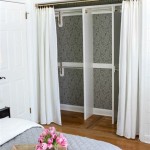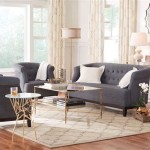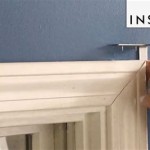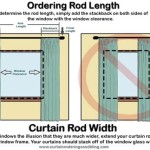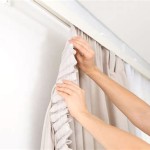Shower Curtain Rods for Tubs: A Comprehensive Guide
Selecting the appropriate shower curtain rod for a bathtub is a crucial aspect of bathroom functionality and aesthetics. The shower curtain rod serves not only as a support for the shower curtain, preventing water from escaping the bathing area, but also contributes significantly to the overall visual appeal of the bathroom. The market offers a diverse range of shower curtain rods, each with its own unique features, installation methods, and suitability for different bathroom layouts. Understanding these variations is essential for making an informed decision that meets specific needs and preferences.
This article provides a comprehensive overview of shower curtain rods specifically designed for bathtubs, delving into the various types available, the materials used in their construction, the installation process, and key considerations for selecting the optimal rod for a given bathroom environment. By exploring these aspects, readers can gain a thorough understanding of the factors that contribute to a well-functioning and visually pleasing shower area.
Types of Shower Curtain Rods
The most common classification of shower curtain rods is based on their shape and installation method. Each type offers distinct advantages and is best suited for specific bathroom configurations. The primary types include straight rods, curved rods, tension rods, and specialized rods designed for unique tub enclosures.
Straight Shower Curtain Rods: Straight rods are the most basic and widely used type. They consist of a simple, linear metal or plastic rod that is typically mounted between two opposing walls. These rods are generally the most affordable and easiest to install, making them a popular choice for standard bathtubs and shower stalls. The simplicity of their design allows them to blend seamlessly with various bathroom styles. Straight rods are commonly secured to the walls using screws and mounting brackets, providing a sturdy and reliable support for the shower curtain. While functional, straight rods offer the least amount of space within the shower area compared to other types.
Curved Shower Curtain Rods: Curved shower curtain rods provide additional elbow room inside the shower or tub enclosure by arching outwards. This design offers a more spacious showering experience and can make a small bathroom feel larger. Curved rods are typically mounted to the walls using screws and brackets, similar to straight rods. The curved shape requires more precise installation to ensure the rod is level and securely attached. The increased space afforded by a curved rod can significantly enhance user comfort. However, curved rods may require longer shower curtains to adequately cover the expanded area.
Tension Shower Curtain Rods: Tension rods offer a simple and damage-free installation method. These rods utilize a spring mechanism to create pressure against the opposing walls of the shower or tub enclosure. The pressure holds the rod in place without the need for screws or drilling. Tension rods are ideal for renters or those who prefer a non-permanent installation. However, tension rods may not be as sturdy as rods that are mounted with screws, especially when supporting heavier shower curtains or liners. It is crucial to select a high-quality tension rod with a strong spring mechanism to ensure adequate support and prevent the rod from slipping. Furthermore, tension rods are most effective when used within a relatively narrow space; wider spans may require additional support.
Corner Shower Curtain Rods: Corner shower curtain rods are designed specifically for bathtubs or shower enclosures located in the corner of a bathroom. These rods typically have an L-shape or a curved configuration that wraps around the corner. Corner rods can be mounted to the walls using screws and brackets or, in some cases, utilize a combination of wall mounts and a ceiling support for added stability. The design ensures complete enclosure of the showering area, preventing water from splashing onto the adjacent walls and floor. Corner shower curtain rods are an excellent solution for maximizing space and functionality in smaller bathrooms where a standard rectangular shower enclosure is not feasible.
Dual Shower Curtain Rods: Dual shower curtain rods feature two parallel rods, allowing for the use of both a decorative shower curtain and a functional liner. This configuration offers increased flexibility and convenience, as the liner can be easily replaced or cleaned without disturbing the decorative curtain. Dual rods are typically mounted to the walls using screws and brackets. They can be either straight or curved, providing a range of options to suit different bathroom styles and spatial needs. The use of dual rods also allows for better ventilation, as the liner and curtain can be separated to promote air circulation and prevent mildew growth.
Materials Used in Shower Curtain Rods
The material used in the construction of a shower curtain rod significantly impacts its durability, appearance, and resistance to corrosion. Common materials include stainless steel, aluminum, chrome-plated steel, and plastic. Each material possesses unique properties that influence its suitability for different bathroom environments and budgets.
Stainless Steel: Stainless steel is a popular choice for shower curtain rods due to its excellent corrosion resistance and durability. This material is inherently resistant to rust and water damage, making it ideal for the humid environment of a bathroom. Stainless steel rods are available in a variety of finishes, including polished, brushed, and matte, allowing them to complement a wide range of bathroom décor styles. While stainless steel rods tend to be more expensive than other options, their longevity and resistance to wear and tear make them a worthwhile investment. The strength of stainless steel also allows it to support heavier shower curtains and liners without sagging or bending.
Aluminum: Aluminum is a lightweight and relatively affordable material that is commonly used in shower curtain rod construction. Aluminum is naturally resistant to corrosion, making it a suitable choice for bathroom environments. However, aluminum is not as strong as stainless steel and may be more prone to bending or denting under heavy use. Aluminum rods are often available in a variety of finishes, including painted and anodized coatings, which can enhance their appearance and provide additional protection against corrosion. The light weight of aluminum makes it easier to install, particularly for tension rods where weight is a factor.
Chrome-Plated Steel: Chrome-plated steel offers a balance between affordability and aesthetics. Chrome plating provides a shiny, reflective surface that can enhance the visual appeal of the rod. However, the underlying steel is susceptible to rust if the chrome plating is scratched or damaged. Therefore, it is important to choose a high-quality chrome-plated rod with a durable coating. Chrome-plated steel rods are relatively strong and can support a reasonable amount of weight. However, they may not be as durable as stainless steel rods in the long term. Regular cleaning and maintenance are essential to prevent rust and maintain the appearance of chrome-plated rods.
Plastic: Plastic shower curtain rods are the most affordable option and are often used in temporary or budget-conscious situations. Plastic rods are lightweight and easy to install, but they are also the least durable option. Plastic is susceptible to bending, cracking, and fading over time, especially when exposed to moisture and sunlight. Plastic rods are typically available in a limited range of colors and styles. While plastic rods may be suitable for short-term use or in less demanding environments, they are not recommended for long-term durability or for supporting heavy shower curtains.
Key Considerations for Selecting a Shower Curtain Rod
Choosing the right shower curtain rod involves careful consideration of several factors, including the size and shape of the bathtub enclosure, the desired aesthetic, the installation method, and the budget. By taking these factors into account, individuals can select a shower curtain rod that effectively meets their needs and enhances the overall functionality and appearance of their bathroom.
Bathroom Dimensions and Layout: The size and shape of the bathtub enclosure are primary determinants of the appropriate shower curtain rod type. Straight rods are suitable for standard rectangular tubs, while curved rods can provide additional space in smaller bathrooms. Corner rods are specifically designed for tubs located in the corner of a room. Accurate measurements of the tub enclosure are essential to ensure that the selected rod fits properly and provides adequate coverage. Consider the overall layout of the bathroom and choose a rod that complements the existing fixtures and décor. A rod that is too large or too small can detract from the visual appeal of the bathroom.
Desired Style and Aesthetics: The shower curtain rod should complement the overall style and aesthetics of the bathroom. Consider the finish of the rod, such as polished chrome, brushed nickel, or matte black, and choose a finish that matches other bathroom fixtures, such as faucets, showerheads, and towel bars. The shape of the rod, whether straight, curved, or angled, can also contribute to the overall visual appeal. For a modern bathroom, a sleek, minimalist straight rod may be appropriate, while a more traditional bathroom may benefit from a curved rod with ornate detailing. Consider the color and pattern of the shower curtain and choose a rod that complements or contrasts with the curtain to create a cohesive look.
Installation Method and Skill Level: The installation method of the shower curtain rod is another important consideration. Tension rods offer the easiest installation, requiring no drilling or special tools. However, they may not be as sturdy as rods that are mounted with screws. Rods that are mounted with screws require more skill and effort to install, but they provide a more secure and stable support. Consider the individual's skill level and comfort with DIY projects when selecting a shower curtain rod. If unfamiliar with drilling or using power tools, a tension rod may be the better option. If looking for a more permanent and robust solution, a rod that is mounted with screws may be preferable. Always follow the manufacturer's instructions carefully when installing the shower curtain rod to ensure proper installation and avoid damage to the walls.
Budgetary Considerations: Shower curtain rods are available in a wide range of prices, depending on the material, style, and features. Plastic rods are the most affordable option, while stainless steel and specialty rods tend to be more expensive. Determine a budget before beginning the search for a shower curtain rod and prioritize the features and qualities that are most important. It is often worth investing in a higher-quality rod that will last longer and provide better support for the shower curtain. Consider the long-term cost of ownership, including the potential for replacement due to damage or wear and tear. A slightly more expensive rod that is more durable may ultimately be a more cost-effective choice in the long run.
Weight Capacity: The weight capacity of the shower curtain rod is a crucial factor, especially when using heavy shower curtains or liners. Ensure that the selected rod is capable of supporting the weight of the curtain without sagging or bending. Check the manufacturer's specifications for the weight capacity of the rod and choose a rod that exceeds the expected weight of the curtain and liner. Overloading the rod can lead to premature failure and potential damage to the bathroom. Reinforcing the rod with additional support brackets may be necessary for particularly heavy curtains or in situations where the rod is exposed to frequent stress.
By carefully considering these various factors, individuals can make an informed decision and select a shower curtain rod that effectively meets their needs, enhances the aesthetics of their bathroom, and provides years of reliable service.

Utopia Alley Hp1bk Hoop Shower Rod For Clawfoot Tub Black

Utopia Alley Hoop Shower Rod For Clawfoot Tub Chrome

S Steel Chrome Extensible Curved Standard Bathtub Shower Fabric Curtain Rod

Utopia Alley 24 In To 58 3 White Fixed Clawfoot Tub Shower Curtain Rod Hp1ww At Com

Utopia Alley Hoop Shower Rod For Clawfoot Tub Bronze Hp1rb The Home

Clawfoot Tub D Rod Shower Enclosure Ring 48 X 66 Inch Chrome

Naiture Stainless Steel Oval Shower Curtain Rod With Ceiling Support For Clawfoot Tub In 60 L X 36 W Black Finish

Oval Solid Brass Shower Curtain Rod Signature Hardware

Diy 360 Hanging Shower Curtain Rod For Freestanding Deep Soak Tub Tips

Signature Hardware 482878 60 X 30 Oval Brass Shower Rod Brushed Gold

